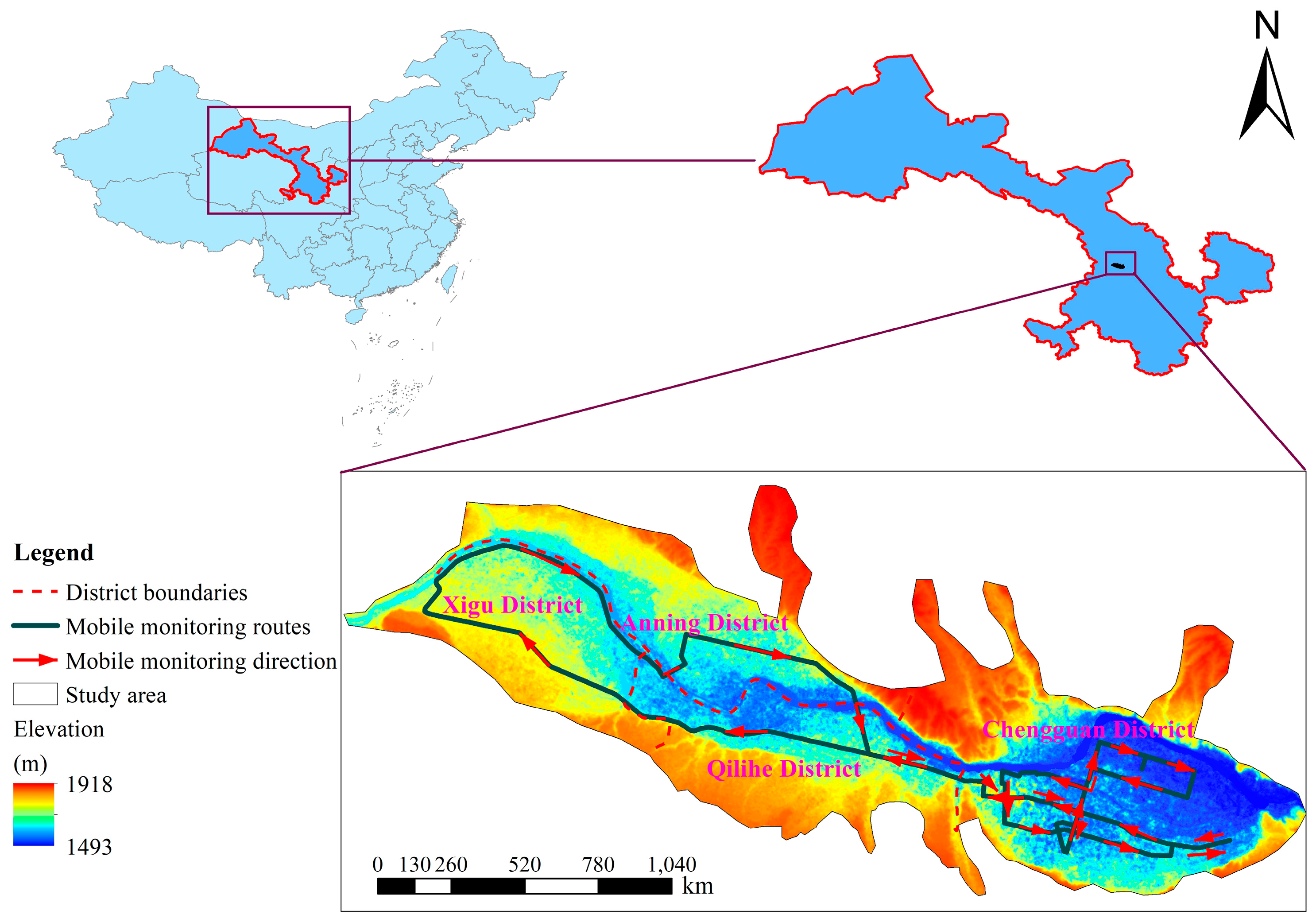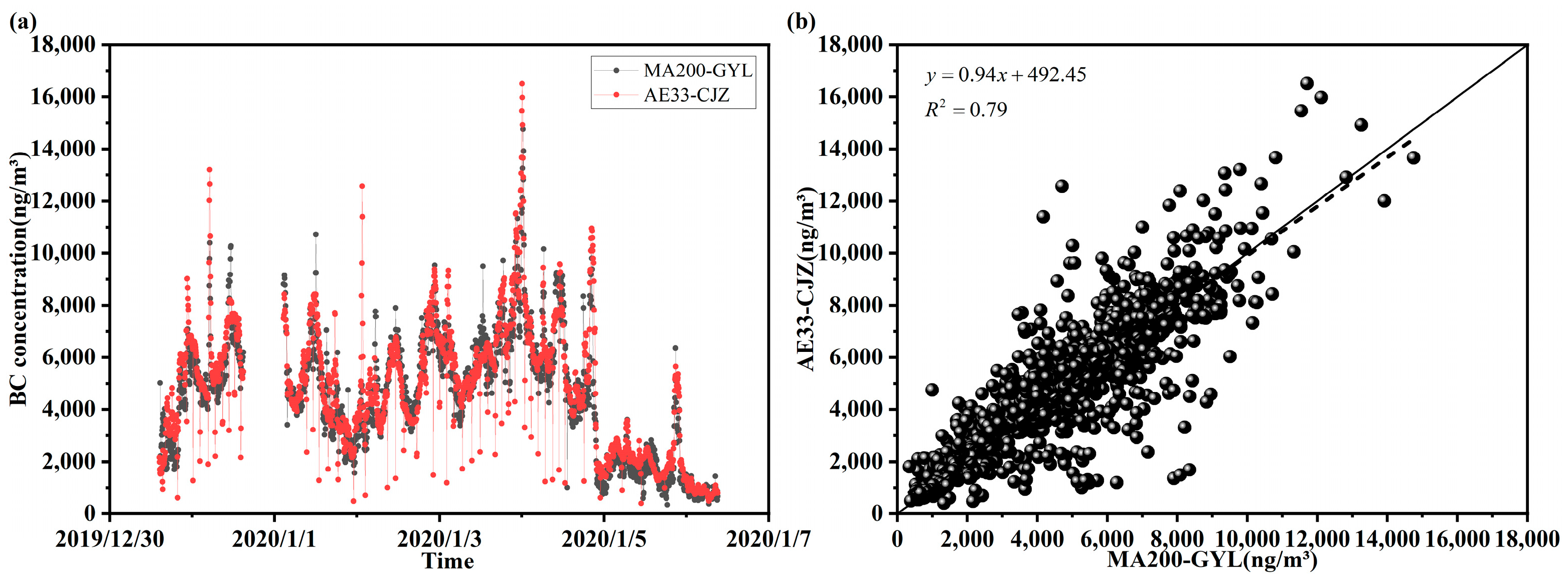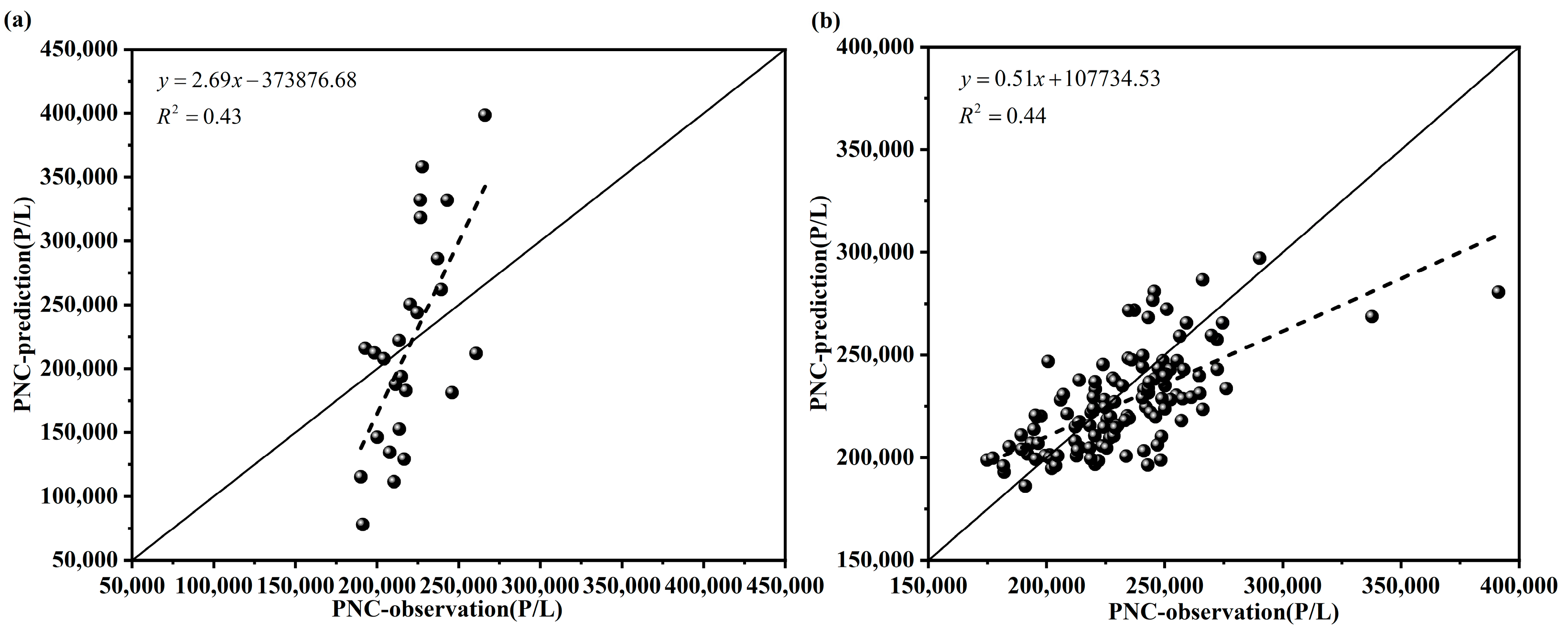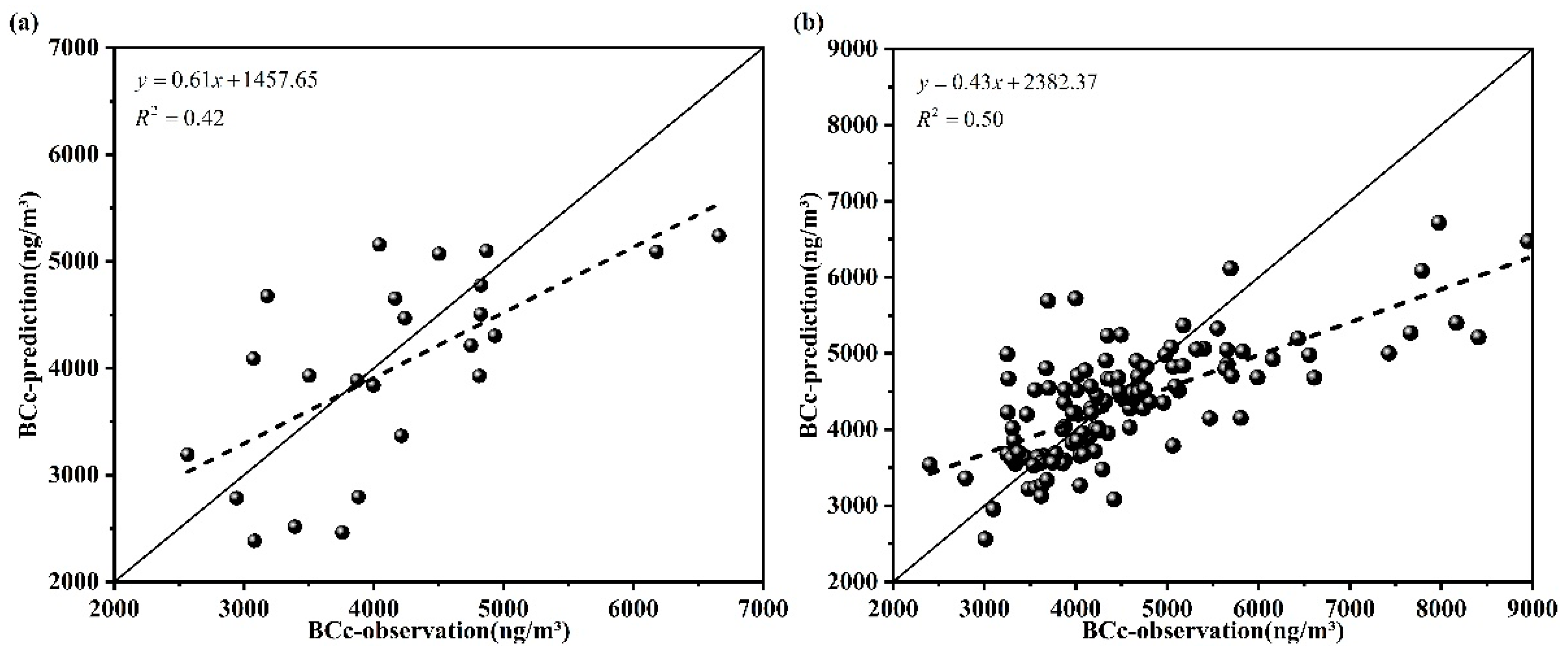Land Use Regression Models for Particle Number Concentration and Black Carbon in Lanzhou, Northwest of China
Abstract
:1. Introduction
2. Materials and Methods
2.1. Mobile Monitoring Campaign
2.2. Potential Predictor Variables
2.3. LUR Model Development
2.4. Model Evaluation
3. Results and Discussion
3.1. Results
3.1.1. LUR Model
3.1.2. Spatial Distribution of Pollutant Concentrations
3.2. Discussion
3.2.1. Comparison of Predicted Concentration and the Fixed Station Observation
3.2.2. Comparison with Previous Mobile Monitoring Studies
3.2.3. Comparison of Model Performance
3.2.4. Variables of the PNC and BC Models
3.2.5. Limitations
4. Conclusions
Author Contributions
Funding
Data Availability Statement
Acknowledgments
Conflicts of Interest
Appendix A

| Categories | Predictor Variables | Description | Unit | Anticipated Directions |
|---|---|---|---|---|
| Road Network | Roadlength | Length of all roads | m | + |
| Trunk | Length of the trunk roads | m | + | |
| Primary | Length of the primary roads | m | + | |
| Secondary | Length of secondary roads | m | + | |
| Tertiary | Length of tertiary roads | m | + | |
| Residential | Length of residential roads | m | + | |
| OTR | Length of unclassified roads | m | + | |
| Motor | Length of highways | m | + | |
| Land Use | Residential | Area of residential and village land | km2 | / |
| Commercial | Area of business and commercial land | km2 | / | |
| Industrial | Area of industrial land | km2 | + | |
| Transportation stations | Area of land for transportation facilities | km2 | + | |
| Public | Area of public building land | km2 | / | |
| Land Cover | Cropland | Area of agricultural land | m2 | / |
| Forest | Area of forested land | m2 | - | |
| Grassland | Area of grass | m2 | - | |
| Shrubland | Area of shrubland | m2 | / | |
| Wetland | Area of wetland | m2 | / | |
| Water | Area of all water bodies | m2 | - | |
| Impervious surface | Area of impermeable surface | m2 | / | |
| Bareland | Area of bareland | m2 | / | |
| Population | Number of population | count | + | |
| Other Types | POI_restaurants | Number of restaurants | count | + |
| Elevation | Elevation of the midpoint of road segment | m | / | |
| Temperature | Surface temperature | °C | / | |
| Relative humidity | Surface relative humidity | / | ||
| Dist water | Distance from the nearest water bodies | m | / | |
| Dist point | Distance from the nearest industrial emission point | m | / |
References
- Kirwa, K.; Szpiro, A.A.; Sheppard, L.; Sampson, P.D.; Wang, M.; Keller, J.P.; Young, M.T.; Kim, S.-Y.; Larson, T.V.; Kaufman, J.D. Fine-Scale Air Pollution Models for Epidemiologic Research: Insights from Approaches Developed in the Multi-ethnic Study of Atherosclerosis and Air Pollution (MESA Air). Curr. Environ. Health Rep. 2021, 8, 113–126. [Google Scholar] [CrossRef]
- Jin, L.; Zhou, T.; Fang, S.; Zhou, X.; Bai, Y. Association of air pollutants and hospital admissions for respiratory diseases in Lanzhou, China, 2014–2019. Environ. Geochem. Health 2022, 45, 941–959. [Google Scholar] [CrossRef] [PubMed]
- Gozzi, F.; Della Ventura, G.; Marcelli, A. Mobile monitoring of particulate matter: State of art and perspectives. Atmos. Pollut. Res. 2016, 7, 228–234. [Google Scholar] [CrossRef]
- Xu, X.; Ha, S.U.; Basnet, R. A Review of Epidemiological Research on Adverse Neurological Effects of Exposure to Ambient Air Pollution. Front. Public Health 2016, 4, 157. [Google Scholar] [CrossRef]
- Blanco, M.N.; Bi, J.; Austin, E.; Larson, T.V.; Marshall, J.D.; Sheppard, L. Impact of Mobile Monitoring Network Design on Air Pollution Exposure Assessment Models. Environ. Sci. Technol. 2023, 57, 440–450. [Google Scholar] [CrossRef] [PubMed]
- Leitte, A.M.; Schlink, U.; Herbarth, O.; Wiedensohler, A.; Pan, X.-C.; Hu, M.; Wehner, B.; Breitner, S.; Peters, A.; Wichmann, H.E.; et al. Associations between size-segregated particle number concentrations and respiratory mortality in Beijing, China. Int. J. Environ. Health Res. 2012, 22, 119–133. [Google Scholar] [CrossRef]
- Breitner, S.; Liu, L.; Cyrys, J.; Brueske, I.; Franck, U.; Schlink, U.; Leitte, A.M.; Herbarth, O.; Wiedensohler, A.; Wehner, B.; et al. Sub-micrometer particulate air pollution and cardiovascular mortality in Beijing, China. Sci. Total Environ. 2011, 409, 5196–5204. [Google Scholar] [CrossRef]
- Dons, E.; Int Panis, L.; Van Poppel, M.; Theunis, J.; Wets, G. Personal exposure to Black Carbon in transport microenvironments. Atmos. Environ. 2012, 55, 392–398. [Google Scholar] [CrossRef]
- Wang, Y.; Li, X.; Shi, Z.; Huang, L.; Li, J.; Zhang, H.; Ying, Q.; Wang, M.; Ding, D.; Zhang, X.; et al. Premature Mortality Associated with Exposure to Outdoor Black Carbon and Its Source Contributions in China. Resour. Conserv. Recycl. 2021, 170, 105620. [Google Scholar] [CrossRef]
- Liu, S.; Huang, Q.; Chen, C.; Song, Y.; Zhang, X.; Dong, W.; Zhang, W.; Zhao, B.; Nan, B.; Zhang, J.; et al. Joint effect of indoor size-fractioned particulate matters and black carbon on cardiopulmonary function and relevant metabolic mechanism: A panel study among school children. Environ. Pollut. 2022, 307, 119533. [Google Scholar] [CrossRef]
- Smith, K.R.; Jerrett, M.; Anderson, H.R.; Burnett, R.T.; Stone, V.; Derwent, R.; Atkinson, R.W.; Cohen, A.; Shonkoff, S.B.; Krewski, D.; et al. Health and Climate Change 5 Public health benefits of strategies to reduce greenhouse-gas emissions: Health implications of short-lived greenhouse pollutants. Lancet 2009, 374, 2091–2103. [Google Scholar] [CrossRef] [PubMed]
- Geng, F.; Hua, J.; Mu, Z.; Peng, L.; Xu, X.; Chen, R.; Kan, H. Differentiating the associations of black carbon and fine particle with daily mortality in a Chinese city. Environ. Res. 2013, 120, 27–32. [Google Scholar] [CrossRef] [PubMed]
- Rahmatinia, M.; Hadei, M.; Hopke, P.K.; Querol, X.; Shahsavani, A.; Namvar, Z.; Kermani, M. Relationship between ambient black carbon and daily mortality in Tehran, Iran: A distributed lag nonlinear time series analysis. J. Environ. Health Sci. Eng. 2021, 19, 907–916. [Google Scholar] [CrossRef]
- Szozda, R. Pneumoconiosis in carbon black workers. J. UOEH 1996, 18, 223–228. [Google Scholar] [CrossRef]
- Wang, S.; Wu, G.; Du, Z.; Wu, W.; Ju, X.; Yimaer, W.; Chen, S.; Zhang, Y.; Li, J.; Zhang, W.; et al. The causal links between long-term exposure to major PM2.5 components and the burden of tuberculosis in China. Sci. Total Environ. 2023, 870, 161745. [Google Scholar] [CrossRef]
- Sun, Y.; Yang, T.; Gui, H.; Li, X.; Wang, W.; Duan, J.; Mao, S.; Yin, H.; Zhou, B.; Lang, J.; et al. Atmospheric environment monitoring technology and equipment in China: A review and outlook. J. Environ. Sci. 2023, 123, 41–53. [Google Scholar] [CrossRef]
- Xiang, S.; Zhang, S.; Wang, H.; Wen, Y.; Yu, Y.T.; Li, Z.; Wallington, T.J.; Shen, W.; Deng, Y.; Tan, Q.; et al. Mobile Measurements of Carbonaceous Aerosol in Microenvironments to Discern Contributions from Traffic and Solid Fuel Burning. Environ. Sci. Technol. Lett. 2021, 8, 867–872. [Google Scholar] [CrossRef]
- Yeom, K. Development of urban air monitoring with high spatial resolution using mobile vehicle sensors. Environ. Monit. Assess. 2021, 193, 375. [Google Scholar] [CrossRef]
- Cai, J.; Ge, Y.; Li, H.; Yang, C.; Liu, C.; Meng, X.; Wang, W.; Niu, C.; Kan, L.; Schikowski, T.; et al. Application of land use regression to assess exposure and identify potential sources in PM2.5, BC, NO2 concentrations. Atmos. Environ. 2020, 223, 117267. [Google Scholar] [CrossRef]
- Birmili, W.; Rehn, J.; Vogel, A.; Boehlke, C.; Weber, K.; Rasch, F. Micro-scale variability of urban particle number and mass concentrations in Leipzig, Germany. Meteorol. Z. 2013, 22, 155–165. [Google Scholar] [CrossRef]
- Samad, A.; Vogt, U. Mobile air quality measurements using bicycle to obtain spatial distribution and high temporal resolution in and around the city center of Stuttgart. Atmos. Environ. 2021, 244, 117915. [Google Scholar] [CrossRef]
- Wang, Y.; Hopke, P.K.; Utell, M.J. Urban-scale Spatial-temporal Variability of Black Carbon and Winter Residential Wood Combustion Particles. Aerosol Air Qual. Res. 2011, 11, 473–481. [Google Scholar] [CrossRef]
- Gulliver, J.; de Hoogh, K.; Hansell, A.; Vienneau, D. Development and Back-Extrapolation of NO2 Land Use Regression Models for Historic Exposure Assessment in Great Britain. Environ. Sci. Technol. 2013, 47, 7804–7811. [Google Scholar] [CrossRef] [PubMed]
- Jin, L.; Berman, J.D.; Zhang, Y.; Thurston, G.; Zhang, Y.; Bell, M.L. Land use regression study in Lanzhou, China: A pilot sampling and spatial characteristics of pilot sampling sites. Atmos. Environ. 2019, 210, 253–262. [Google Scholar] [CrossRef]
- Briggs, D.J.; Collins, S.; Elliott, P.; Fischer, P.; Kingham, S.; Lebret, E.; Pryl, K.; Van Reeuwijk, H.; Smallbone, K.; Van Der Veen, A. Mapping urban air pollution using GIS: A regression-based approach. Int. J. Geogr. Inf. Sci. 1997, 11, 699–718. [Google Scholar] [CrossRef]
- Gillespie, J.; Beverland, I.J.; Hamilton, S.; Padmanabhan, S. Development, Evaluation, and Comparison of Land Use Regression Modeling Methods to Estimate Residential Exposure to Nitrogen Dioxide in a Cohort Study. Environ. Sci. Technol. 2016, 50, 11085–11093. [Google Scholar] [CrossRef] [PubMed]
- Ryan, P.H.; LeMasters, G.K. A Review of Land-use Regression Models for Characterizing Intraurban Air Pollution Exposure. Inhal. Toxicol. 2007, 19, 127–133. [Google Scholar] [CrossRef] [PubMed]
- Brauer, M.; Hoek, G.; van Vliet, P.; Meliefste, K.; Fischer, P.; Gehring, U.; Heinrich, J.; Cyrys, J.; Bellander, T.; Lewne, M.; et al. Estimating Long-Term Average Particulate Air Pollution Concentrations: Application of Traffic Indicators and Geographic Information Systems. Epidemiology 2003, 14, 228–239. [Google Scholar] [CrossRef]
- Zou, B.; Luo, Y.; Wan, N.; Zheng, Z.; Sternberg, T.; Liao, Y. Performance comparison of LUR and OK in PM2.5 concentration mapping: A multidimensional perspective. Sci. Rep. 2015, 5, 8698. [Google Scholar] [CrossRef]
- Rahman, M.M.; Karunasinghe, J.; Clifford, S.; Knibbs, L.D.; Morawska, L. New insights into the spatial distribution of particle number concentrations by applying non-parametric land use regression modelling. Sci. Total Environ. 2020, 702, 134708. [Google Scholar] [CrossRef]
- Liu, X.; Schnelle-Kreis, J.; Zhang, X.; Bendl, J.; Khedr, M.; Jakobi, G.; Schloter-Hai, B.; Hovorka, J.; Zimmermann, R. Integration of air pollution data collected by mobile measurement to derive a preliminary spatiotemporal air pollution pro file from two neighboring German-Czech border villages. Sci. Total Environ. 2020, 722, 137632. [Google Scholar] [CrossRef] [PubMed]
- Liu, X.; Hadiatullah, H.; Khedr, M.; Zhang, X.; Schnelle-Kreis, J.; Zimmermann, R.; Adam, T. Personal exposure to various size fractions of ambient particulate matter during the heating and non-heating periods using mobile monitoring approach: A case study in Augsburg, Germany. Atmos. Pollut. Res. 2022, 13, 101483. [Google Scholar] [CrossRef]
- Patton, A.P.; Collins, C.; Naumova, E.N.; Zamore, W.; Brugge, D.; Durant, J.L. An Hourly Regression Model for Ultrafine Particles in a Near-Highway Urban Area. Environ. Sci. Technol. 2014, 48, 3272–3280. [Google Scholar] [CrossRef]
- Simon, M.C.; Patton, A.P.; Naumova, E.N.; Levy, J.I.; Kumar, P.; Brugge, D.; Durant, J.L. Combining Measurements from Mobile Monitoring and a Reference Site to Develop Models of Ambient Ultrafine Particle Number Concentration at Residences. Environ. Sci. Technol. 2018, 52, 6985–6995. [Google Scholar] [CrossRef] [PubMed]
- Cattani, G.; Gaeta, A.; di Bucchianico, A.D.M.; De Santis, A.; Gaddi, R.; Cusano, M.; Ancona, C.; Badaloni, C.; Forastiere, F.; Gariazzo, C.; et al. Development of land-use regression models for exposure assessment to ultrafine particles in Rome, Italy. Atmos. Environ. 2017, 156, 52–60. [Google Scholar] [CrossRef]
- Sabaliauskas, K.; Jeong, C.-H.; Yao, X.; Reali, C.; Sun, T.; Evans, G.J. Development of a land-use regression model for ultrafine particles in Toronto, Canada. Atmos. Environ. 2015, 110, 84–92. [Google Scholar] [CrossRef]
- Wolf, K.; Cyrys, J.; Harcinikova, T.; Gu, J.; Kusch, T.; Hampel, R.; Schneider, A.; Peters, A. Land use regression modeling of ultrafine particles, ozone, nitrogen oxides and markers of particulate matter pollution in Augsburg, Germany. Sci. Total Environ. 2017, 579, 1531–1540. [Google Scholar] [CrossRef]
- Hoek, G.; Beelen, R.; Kos, G.; Dijkema, M.; van der Zee, S.C.; Fischer, P.H.; Brunekreef, B. Land Use Regression Model for Ultrafine Particles in Amsterdam. Environ. Sci. Technol. 2011, 45, 622–628. [Google Scholar] [CrossRef]
- Boniardi, L.; Dons, E.; Campo, L.; Van Poppel, M.; Int Panis, L.; Fustinoni, S. Annual, seasonal, and morning rush hour Land Use Regression models for black carbon in a school catchment area of Milan, Italy. Environ. Res. 2019, 176, 108520. [Google Scholar] [CrossRef]
- Kerckhoffs, J.; Hoek, G.; Vlaanderen, J.; van Nunen, E.; Messier, K.; Brunekreef, B.; Gulliver, J.; Vermeulen, R. Robustness of intra urban land-use regression models for ultrafine particles and black carbon based on mobile monitoring. Environ. Res. 2017, 159, 500–508. [Google Scholar] [CrossRef]
- Talaat, H.; Xu, J.; Hatzopoulou, M.; Abdelgawad, H. Mobile monitoring and spatial prediction of black carbon in Cairo, Egypt. Environ. Monit. Assess. 2021, 193, 587. [Google Scholar] [CrossRef]
- Hankey, S.; Marshall, J.D. On-bicycle exposure to particulate air pollution: Particle number, black carbon, PM2.5, and particle size. Atmos. Environ. 2015, 122, 65–73. [Google Scholar] [CrossRef]
- Xu, X.; Qin, N.; Qi, L.; Zou, B.; Cao, S.; Zhang, K.; Yang, Z.; Liu, Y.; Zhang, Y.; Duan, X. Development of season-dependent land use regression models to estimate BC and PM1 exposure. Sci. Total Environ. 2021, 793, 148540. [Google Scholar] [CrossRef]
- Liu, M.; Peng, X.; Meng, Z.; Zhou, T.; Long, L.; She, Q. Spatial characteristics and determinants of in-traffic black carbon in Shanghai, China: Combination of mobile monitoring and land use regression model. Sci. Total Environ. 2019, 658, 51–61. [Google Scholar] [CrossRef]
- Hagler, G.; Yelverton, T.; Vedantham, R.; Hansen, A.; Turner, J. Post-processing Method to Reduce Noise while Preserving High Time Resolution in Aethalometer Real-time Black Carbon Data. Aerosol Air Qual. Res. 2011, 11, 539–546. [Google Scholar] [CrossRef]
- Goel, A.; Kumar, P. A review of fundamental drivers governing the emissions, dispersion and exposure to vehicle-emitted nanoparticles at signalised traffic intersections. Atmos. Environ. 2014, 97, 316–331. [Google Scholar] [CrossRef]
- Jayaratne, E.R.; Wang, L.; Heuff, D.; Morawska, L.; Ferreira, L. Increase in particle number emissions from motor vehicles due to interruption of steady traffic flow. Transp. Res. Part D Transp. Environ. 2009, 14, 521–526. [Google Scholar] [CrossRef]
- Hankey, S.; Marshall, J.D. Land Use Regression Models of On-Road Particulate Air Pollution (Particle Number, Black Carbon, PM2.5, Particle Size) Using Mobile Monitoring. Environ. Sci. Technol. 2015, 49, 9194–9202. [Google Scholar] [CrossRef] [PubMed]
- Tessum, M.W.; Sheppard, L.; Larson, T.V.; Gould, T.R.; Kaufman, J.D.; Vedal, S. Improving Air Pollution Predictions of Long-Term Exposure Using Short-Term Mobile and Stationary Monitoring in Two US Metropolitan Regions. Environ. Sci. Technol. 2021, 55, 3530–3538. [Google Scholar] [CrossRef]
- Presto, A.A.; Saha, P.K.; Robinson, A.L. Past, present, and future of ultrafine particle exposures in North America. Atmos. Environ. X 2021, 10, 100109. [Google Scholar] [CrossRef]
- Bertazzon, S.; Couloigner, I.; Mirzaei, M. Spatial regression modelling of particulate pollution in Calgary, Canada. GeoJournal 2022, 87, 2141–2157. [Google Scholar] [CrossRef] [PubMed]
- Eeftens, M.; Beelen, R.; de Hoogh, K.; Bellander, T.; Cesaroni, G.; Cirach, M.; Declercq, C.; Dedele, A.; Dons, E.; de Nazelle, A.; et al. Development of Land Use Regression Models for PM2.5, PM2.5 Absorbance, PM10 and PMcoarse in 20 European Study Areas; Results of the ESCAPE Project. Environ. Sci. Technol. 2012, 46, 11195–11205. [Google Scholar] [CrossRef] [PubMed]
- Zhang, Y.; Kang, S. Characteristics of carbonaceous aerosols analyzed using a multiwavelength thermal/optical carbon analyzer: A case study in Lanzhou City. Sci. China Earth Sci. 2019, 62, 389–402. [Google Scholar] [CrossRef]
- Chen, P.; Kang, S.; Gan, Q.; Yu, Y.; Yuan, X.; Liu, Y.; Tripathee, L.; Wang, X.; Li, C. Concentrations and light absorption properties of PM2.5 organic and black carbon based on online measurements in Lanzhou, China. J. Environ. Sci. 2023, 131, 84–95. [Google Scholar] [CrossRef] [PubMed]
- Zhang, X.; Li, Z.; Wang, F.; Song, M.; Zhou, X.; Ming, J. Carbonaceous Aerosols in PM1, PM2.5, and PM10 Size Fractions over the Lanzhou City, Northwest China. Atmosphere 2020, 11, 1368. [Google Scholar] [CrossRef]
- Tan, J.; Zhang, L.; Zhou, X.; Duan, J.; Li, Y.; Hu, J.; He, K. Chemical characteristics and source apportionment of PM2.5 in Lanzhou, China. Sci. Total Environ. 2017, 601, 1743–1752. [Google Scholar] [CrossRef]
- Wang, Y.; Jia, C.; Tao, J.; Zhang, L.; Liang, X.; Ma, J.; Gao, H.; Huang, T.; Zhang, K. Chemical characterization and source apportionment of PM2.5 in a semi-arid and petrochemical-industrialized city, Northwest China. Sci. Total Environ. 2016, 573, 1031–1040. [Google Scholar] [CrossRef]
- Xu, J.; Zhang, M.; Ganji, A.; Mallinen, K.; Wang, A.; Lloyd, M.; Venuta, A.; Simon, L.; Kang, J.; Gong, J.; et al. Prediction of Short-Term Ultrafine Particle Exposures Using Real-Time Street-Level Images Paired with Air Quality Measurements. Environ. Sci. Technol. 2022, 56, 12886–12897. [Google Scholar] [CrossRef]
- Gani, S.; Chambliss, S.E.; Messier, K.P.; Lunden, M.M.; Apte, J.S. Spatiotemporal profiles of ultrafine particles differ from other traffic-related air pollutants: Lessons from long-term measurements at fixed sites and mobile monitoring. Environ. Sci. Atmos. 2021, 1, 558–568. [Google Scholar] [CrossRef]
- Zhou, X.; Zhou, T.; Fang, S.; Han, B.; He, Q. Investigation of the Vertical Distribution Characteristics and Microphysical Properties of Summer Mineral Dust Masses over the Taklimakan Desert Using an Unmanned Aerial Vehicle. Remote Sens. 2023, 15, 3556. [Google Scholar] [CrossRef]
- Blanco-Donado, E.P.; Schneider, I.L.; Artaxo, P.; Lozano-Osorio, J.; Portz, L.; Oliveira, M.L.S. Source identification and global implications of black carbon. Geosci. Front. 2022, 13, 101149. [Google Scholar] [CrossRef]
- Gidhagen, L.; Krecl, P.; Targino, A.C.; Polezer, G.; Godoi, R.H.M.; Felix, E.; Cipoli, Y.A.; Charres, I.; Malucelli, F.; Wolf, A.; et al. An integrated assessment of the impacts of PM2.5 and black carbon particles on the air quality of a large Brazilian city. Air Qual. Atmos. Health 2021, 14, 1455–1473. [Google Scholar] [CrossRef]
- Hove, A.V.D.; Verwaeren, J.; Bossche, J.V.D.; Theunis, J.; Baets, B.D. Development of a land use regression model for black carbon using mobile monitoring data and its application to pollution-avoiding routing. Environ. Res. 2019, 183, 108619. [Google Scholar] [CrossRef] [PubMed]
- Saha, P.K.; Hankey, S.; Marshall, J.D.; Robinson, A.L.; Presto, A.A. High-Spatial-Resolution Estimates of Ultrafine Particle Concentrations across the Continental United States. Environ. Sci. Technol. 2021, 55, 10320–10331. [Google Scholar] [CrossRef] [PubMed]
- Chang, T.-Y.; Tsai, C.-C.; Wu, C.-F.; Chang, L.-T.; Chuang, K.-J.; Chuang, H.-C.; Young, L.-H. Development of land-use regression models to estimate particle mass and number concentrations in Taichung, Taiwan. Atmos. Environ. 2021, 252, 118303. [Google Scholar] [CrossRef]
- Yang, Z.; Freni-Sterrantino, A.; Fuller, G.W.; Gulliver, J. Development and transferability of ultrafine particle land use regression models in London. Sci. Total Environ. 2020, 740, 140059. [Google Scholar] [CrossRef]
- Lloyd, M.; Carter, E.; Diaz, F.G.; Magara-Gomez, K.T.; Hong, K.Y.; Baumgartner, J.; Herrera, G.V.M.; Weichenthal, S. Predicting Within-City Spatial Variations in Outdoor Ultrafine Particle and Black Carbon Concentrations in Bucaramanga, Colombia: A Hybrid Approach Using Open-Source Geographic Data and Digital Images. Environ. Sci. Technol. 2021, 55, 12483–12492. [Google Scholar] [CrossRef]
- Jin, L.; Zhou, T.; Fang, S.; Zhou, X.; Han, B.; Bai, Y. The short-term effects of air pollutants on pneumonia hospital admissions in Lanzhou, China, 2014–2019: Evidence of ecological time-series study. Air Qual. Atmos. Health 2022, 15, 2199–2213. [Google Scholar] [CrossRef]
- Zhao, S.; Yu, Y.; Yin, D.; Yu, Z.; Dong, L.; Mao, Z.; He, J.; Yang, J.; Li, P.; Qin, D. Concentrations, optical and radiative properties of carbonaceous aerosols over urban Lanzhou, a typical valley city: Results from in-situ observations and numerical model. Atmos. Environ. 2019, 213, 470–484. [Google Scholar] [CrossRef]
- Zhou, T.; Xie, H.; Jiang, T.; Huang, J.; Bi, J.; Huang, Z.; Shi, J. Seasonal characteristics of aerosol vertical structure and autumn enhancement of non-spherical particle over the semi-arid region of northwest China. Atmos. Environ. 2021, 244, 117912. [Google Scholar] [CrossRef]





| Categories | Data Sources | Time | |
|---|---|---|---|
| Road Network | OSM (https://www.openstreetmap.org/, accessed on 1 November 2021) | 2019 | |
| Land Use | FROM-GLC (http://data.ess.tsinghua.edu.cn, accessed on 1 November 2021) | 2017 | |
| Land Cover | EULUC-China (http://data.ess.tsinghua.edu.cn, accessed on 1 November 2021) | 2018 | |
| Population | WorldPop (www.worldpop.org, accessed on 1 November 2021) | 2020 | |
| Other types | POI_restaurants | OSM (https://www.openstreetmap.org/, accessed on 1 November 2021) | 2019 |
| Elevation | Geospatial Data Cloud (http://www.gscloud.cn/, accessed on 1 November 2021) | 2009 | |
| Temperature | Mobile Monitoring data | 2020 | |
| Relative humidity | Mobile Monitoring data | 2020 | |
| Dist water | Calculated by GIS | 2018 | |
| Dist point | Calculated by GIS | 2019 | |
| Pollutant | LUR Model a | Adj R2 b | HV c R2 | HV RMSE d | LOOCV e R2 | LOOCV RMSE |
|---|---|---|---|---|---|---|
| PNC | 0.51 | 0.43 | 70,297.93 P/L | 0.44 | 23,284.94 P/L | |
| BC | 0.53 | 0.42 | 801.32 ng/m3 | 0.50 | 886.62 ng/m3 |
Disclaimer/Publisher’s Note: The statements, opinions and data contained in all publications are solely those of the individual author(s) and contributor(s) and not of MDPI and/or the editor(s). MDPI and/or the editor(s) disclaim responsibility for any injury to people or property resulting from any ideas, methods, instructions or products referred to in the content. |
© 2023 by the authors. Licensee MDPI, Basel, Switzerland. This article is an open access article distributed under the terms and conditions of the Creative Commons Attribution (CC BY) license (https://creativecommons.org/licenses/by/4.0/).
Share and Cite
Fang, S.; Zhou, T.; Jin, L.; Zhou, X.; Li, X.; Song, X.; Wang, Y. Land Use Regression Models for Particle Number Concentration and Black Carbon in Lanzhou, Northwest of China. Sustainability 2023, 15, 12828. https://doi.org/10.3390/su151712828
Fang S, Zhou T, Jin L, Zhou X, Li X, Song X, Wang Y. Land Use Regression Models for Particle Number Concentration and Black Carbon in Lanzhou, Northwest of China. Sustainability. 2023; 15(17):12828. https://doi.org/10.3390/su151712828
Chicago/Turabian StyleFang, Shuya, Tian Zhou, Limei Jin, Xiaowen Zhou, Xingran Li, Xiaokai Song, and Yufei Wang. 2023. "Land Use Regression Models for Particle Number Concentration and Black Carbon in Lanzhou, Northwest of China" Sustainability 15, no. 17: 12828. https://doi.org/10.3390/su151712828
APA StyleFang, S., Zhou, T., Jin, L., Zhou, X., Li, X., Song, X., & Wang, Y. (2023). Land Use Regression Models for Particle Number Concentration and Black Carbon in Lanzhou, Northwest of China. Sustainability, 15(17), 12828. https://doi.org/10.3390/su151712828






